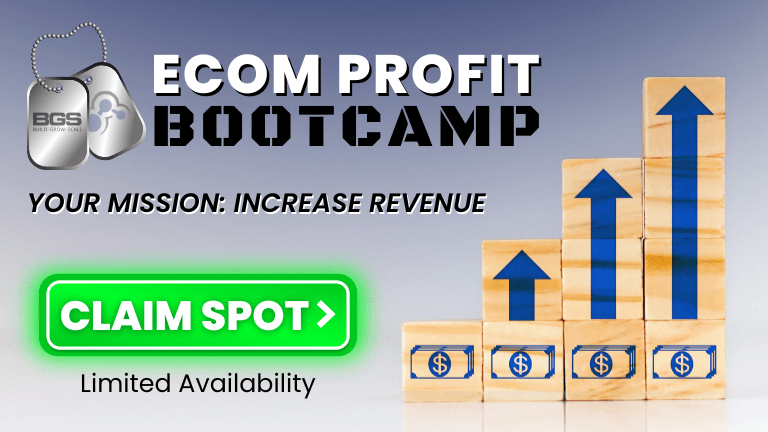5 Powerful Ecommerce Content Marketing Tactics to Boost Success

If you’re anything like me, you’ve probably spent countless hours trying to perfect your eCommerce content marketing game. You’ve read all the basics, mastered SEO techniques, and maybe even seen some success in driving traffic to your site.
But let’s face it; there’s always room for improvement, especially when it comes to standing out from the ever-growing sea of competitors.
That’s where this article comes in. We’re going beyond the basics and diving deep into some next-level strategies that’ll give you more control over your eCommerce content marketing success.
Trust me, once you start implementing these tactics, you’ll wonder how you ever managed without them. So buckle up and get ready to level up your online selling game like never before!
1. Crafting An Engaging Content Strategy
Let’s face it, we all want to be in control of our business’s success – and one way to take the reins is by developing a killer content strategy for your eCommerce site.
You’ve got the basics down: product descriptions, blog posts, and social media updates. But now it’s time to level up your game and create a truly engaging content strategy that not only keeps your customers hooked but also turns them into raving fans.
You know what they say: ‘Content is king.’ And who wouldn’t want to rule their own kingdom?
The secret to building an empire lies in creating content that resonates with your target audience and compels them to take action – whether that means making a purchase, signing up for your newsletter, or sharing your latest post with their friends.
To do this, you’ll need to dive deep into your audience’s desires, fears, and aspirations – understand what makes them tick and tailor your content accordingly.
Don’t just stop at knowing who your audience is; get personal! Use data-driven insights from tools like Google Analytics or customer surveys to identify trends in behavior and preferences among your shoppers.
Are they seeking solutions for specific problems? Do they crave unique experiences? Once you’ve got a grasp on their needs and wants, make sure every piece of content you produce speaks directly to those desires.
This way, you’re not just giving them what they think they want – you’re providing them with something they can’t resist.
The real magic happens when you add value beyond the products themselves.
Offer expert advice through blog posts that address common pain points or share behind-the-scenes glimpses of how products are made or sourced.
Create captivating video tutorials or host exclusive webinars that empower customers with knowledge about using your products most effectively.
By going above and beyond in delivering valuable content catered specifically to your audience’s desires for control and mastery over their own lives, you’ll solidify their loyalty and turn casual browsers into lifelong customers.
Trust me – they won’t be able to get enough of your content!
2. Utilizing Targeted Keywords
Picture this: you’ve crafted the perfect content marketing strategy, complete with dazzling blog posts and eye-catching graphics, but one crucial piece of the puzzle is missing – targeted keywords.
It’s like having a beautiful store with incredible products but hiding it in a dark alley where no one can find it. Don’t let your hard work go to waste!
By understanding and utilizing targeted keywords effectively, you empower your brand to climb search engine rankings and reach your ideal customers.
First things first, what are targeted keywords? They’re specific words or phrases that are highly relevant to your business niche and target audience. These little gems guide search engines to understand what your content is all about and help them match it with users searching for similar information.
For instance, if you sell eco-friendly cleaning products, some targeted keywords might be ‘natural cleaning solutions’ or ‘green cleaning supplies’. Remember, it’s not just about attracting more traffic; it’s about attracting the right kind of traffic – people who are genuinely interested in what you offer.
Now that we’ve covered the basics, let’s dive deeper into how to effectively use these powerful tools. Start by conducting thorough keyword research. This means analyzing which terms are popular within your niche, as well as assessing how competitive they are in search engine results.
Several online tools can help with this task – such as Google Keyword Planner or SEMrush – but don’t forget about good old-fashioned brainstorming sessions! Gather your team together and think about the words or phrases that potential customers might use when searching for your products or services.
Once you have a solid list of keywords, weave them throughout your content organically (no keyword stuffing here), ensuring they appear in strategic locations such as titles, headings, URLs, meta descriptions, and image alt tags.
So there you have it – the secret sauce to elevating your ecommerce content marketing game using targeted keywords. It may seem daunting at first glance, but with a bit of research and creativity, you’ll be well on your way to harnessing the power of search engine optimization (SEO) and capturing the attention of your ideal customers.
Remember, when it comes to online success, visibility is key – and by implementing targeted keywords effectively, you’re taking control of how easily your audience can find and connect with your brand. Don’t settle for being hidden in the shadows; step into the spotlight and let your content shine!
3. Leveraging Content On Social Media Platforms
Ah, social media – the ultimate playground for ecommerce marketers. It’s not enough to just have a presence on these platforms; you need to know how to strategically leverage them for maximum impact.
With millions of users scrolling through their feeds daily, there’s a tremendous opportunity to engage with your target audience and convert them into loyal customers. But how do you stand out in the crowded world of social media? Let’s dive into some tactics that can take your ecommerce content marketing game to new heights.
First things first, you’ll want to identify which social media platforms are best suited for your brand and products. Not all platforms are created equal, and what works on one may not necessarily work on another.
For example, if you’re selling visually appealing products like clothing or home decor, Instagram and Pinterest should be at the top of your list. If you’re more focused on building thought leadership in your industry, LinkedIn might be a better fit. The key is understanding where your target audience hangs out online and tailoring your strategy accordingly.
Now that you’ve identified your ideal platforms, it’s time to get creative with your content. There’s no denying that eye-catching visuals are crucial for success on social media, but standing out requires more than just pretty pictures – it demands storytelling.
Think about ways to showcase your products in real-life situations or share customer testimonials highlighting the unique benefits of your selling. And don’t forget to mix it up! A healthy mix of promotional content (think sales and discounts) alongside educational or entertaining pieces will keep users engaged without feeling overwhelmed by sales pitches.
So, we’ve covered choosing the right platform and producing engaging content – now, let’s talk about amplifying reach through influencers and partnerships.
Collaborating with influencers who resonate with your target audience can help increase brand awareness while also introducing potential customers to interesting ways they can use or style your products. Additionally, consider partnering with complementary brands or companies within your industry to create joint content or promotions.
Not only does this expose your brand to a larger audience, but it also adds credibility and trustworthiness, as consumers often view collaborations in a positive light.
By strategically leveraging social media platforms, creating engaging content, and fostering valuable partnerships, you’ll be well on your way to dominating the ecommerce content marketing space.
Remember that gaining traction on social media doesn’t happen overnight; it requires consistent effort and a willingness to adapt and learn from both successes and failures. So go ahead – take the plunge into the world of social media marketing, and watch as your ecommerce business soars to new heights.
4. Optimizing Your Content For Search Engines
Now that you’ve mastered the art of leveraging social media platforms, it’s time to dive deeper into another crucial aspect of ecommerce content marketing: search engine optimization (SEO). The truth is, your brand can have the most amazing content in the world, but if it’s not ranking on Google, you’re missing out on a significant amount of potential customers. So let’s discuss how to optimize your content for search engines and get your website in front of more eyes.
First things first, let’s talk about keywords. Keywords are the bread and butter of SEO – they’re what help search engines understand what your content is about and how relevant it is to a user’s query. Start by conducting thorough keyword research to identify the terms that your target audience is searching for in relation to your products or services. Once you have this list, sprinkle these keywords throughout your content – but be careful not to overdo it. Keyword stuffing will only hurt your chances of ranking well on Google.
Next up: meta tags. These little bits of HTML code might seem small and insignificant, but they play a big role in helping search engines understand and index your content properly. Make sure each page on your website has unique meta titles and descriptions that accurately reflect the content found within. This not only helps with SEO but also improves click-through rates from search results pages, as users are more likely to click on a link that clearly outlines what they can expect when they land on your site.
We’ve covered two essential elements of optimizing your ecommerce site for search engines: keyword usage and meta tags. However, don’t forget about other factors like mobile-friendliness, site speed, internal linking structure, and high-quality backlinks from reputable sources.
All of these contribute to a comprehensive SEO strategy that will increase organic traffic to your online store and ultimately lead to more sales and revenue for your business.
Remember, great content means nothing if no one can find it – put in the effort to optimize your site for search engines and watch your ecommerce business soar.
5. Analyzing And Refining Your Marketing Results
Now that you’ve got the basics of eCommerce content marketing down, it’s time to dive deeper into optimizing your strategy. The key to success in any marketing endeavor is analyzing and refining your results. But don’t worry; I’m here to guide you through this process so you can achieve the best possible outcomes for your business.
First things first, you’ll want to set goals and track your progress. What are you hoping to achieve with your content marketing efforts? Increased traffic, better conversion rates, or maybe even improved customer loyalty?
Whatever your objectives may be, be sure to measure relevant metrics such as traffic sources, bounce rates, social shares, and conversions. Tools like Google Analytics and SEMrush can come in handy when monitoring these metrics. This way, you’ll have a clear understanding of what works and what doesn’t.
Next up: A/B testing. This is an essential practice for any marketer looking to refine their strategy. By comparing two variations of the same piece of content or campaign element (such as headlines or images), you can determine which one performs better in terms of engagement and conversion rates.
Don’t be afraid to experiment with different approaches – remember that control comes from understanding how each tweak affects performance. Keep iterating until you find the perfect formula for success!
So there you have it – a deep dive into analyzing and refining your results for eCommerce content marketing domination! Remember that this process is ongoing; don’t expect overnight success but rather continuous improvement as you learn more about your audience’s preferences and behaviors.
Embrace this journey towards mastery, knowing that by doing so, you’re gaining greater control over the future growth and prosperity of your online business. Happy optimizing!
Conclusion
In conclusion, it’s essential for you to go beyond the basics and craft an engaging content strategy that speaks directly to your target audience. Don’t forget to utilize targeted keywords, leverage social media platforms, and optimize your content for search engines.
Remember, analyzing and refining your results is crucial for continuous improvement. So keep measuring your success and stay committed to delivering valuable content.
You’ve got this!





